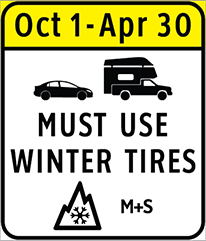Wintery conditions can make roads difficult and even dangerous to traverse. In fact, winter driving can be so hazardous, some provinces like British Columbia – home of the Coquihalla highway and the nefariously foggy connector, have made winter tires mandatory on some roads. Prior to purchasing a new set of tires it’s critical to understand your options and some general best practices.
All season, all weather or winter tires?
Winter tires or chains are required on most routes in BC from October 1 to April 30. For select highways not located through mountain passes and/or high snowfall areas, tire and chain requirements end March 31.
While the winter tire is the preferred choice in cold weather, there is another popular option that works well in the Lower Mainland. It’s the all-weather tire.
Both the winter tire and the all-weather tire have the three peak snowflake and M + S symbol.

All season tires have the M + S symbol, representing mud and snow, and in BC they are considered the minimum acceptable winter tire. However, you could be turned away on some roads where only tires bearing the three peak snow flake symbol and the M + S are allowed.
According to CTV news report, Kal Tire spokesperson Bill Gardiner explains, “A winter tire has tremendous grip at low temperature. While all-season tires are generally good in three seasons, they start to lose their grip when temperature falls below 7 C, whether on wet pavement or in snow.”
Good to know facts about winter tires
- While all-season tires are made for a variety of conditions, winter tires are built specifically to perform in low temperatures, ice, slush and snow.
- Driving tests have proven it that winter tires have superior braking, manoeuvring and acceleration capabilities in colder weather compared to all-season tires.
- Effective winter tires will have at least a 3.5 millimetre tread as well as a symbol of a mountain and a snowflake. This symbol indicates the tires have good traction on ice and snow.
- It’s important to never mix different styles of tires, as this can compromise overall stability.
- You should maintain air pressure in your winter tires to extend tread lifespan.
- Inspect your winter tires regularly for cracks, cuts or bulges. Replace tires immediately if you suspect they are failing or if the tread is especially worn.
Knowing the different types of tires is important to your overall safety and making the right purchasing decision. There are a variety of different tires on the market, including all-season, all-weather, high-performance, all-terrain and snow tires. It’s important to do thorough research and to speak to an expert before fitting your vehicle with tires.
Winter tires are critical to road safety in hazardous conditions. In fact, when compared to all-season tires, vehicles equipped with winter tires have been shown to decrease the stopping distance of a car by 30 to 40 per cent.
Best practices for storing tires
It is recommended to store tires in a tire bag, tied and taped to prolong their life. A tire has about a 6 year shelf life, because tires breakdown over time when exposed to air. Many drivers choose not to change to a seasonal model, but if you are driving on winter or mountain roads it is well worth the effort and cost. Many tire places have a service to help with the transition and even storage options – this is very convenient for condo dwellers who may not have storage options.
Get organized for winter tires early in the season
It all started with a toilet paper shortage and has progressed to most goods from furniture, to lumper to semiconductor chips.The supply chains have been interrupted. And wait for it, reported in May 2021 in Car and Driver, we could see a tire shortage. This is due to demand for tires in china, to Covid manufacturing disruptions and a shortage of rubber. We recommend that you head over to your favorite tire place and put in your order asap. The winter 2020 season resulted in sold out winter tires, which was a problem for those families hoping to hit the local slopes. Both Cypress Mountain and Seymour mountain along with all of the larger ski resorts require winter tires.
Resources
Reliance Insurance: Winter driving skills
CTV News: Are all season tires good enough for winter driving?
Car & Driver: Tire shortage possible
ICBC: Winter tires
Reliance Insurance: Know the pros and cons of run flat tires




Reliance Insurance proudly serves
Burnaby and the Vancouver area